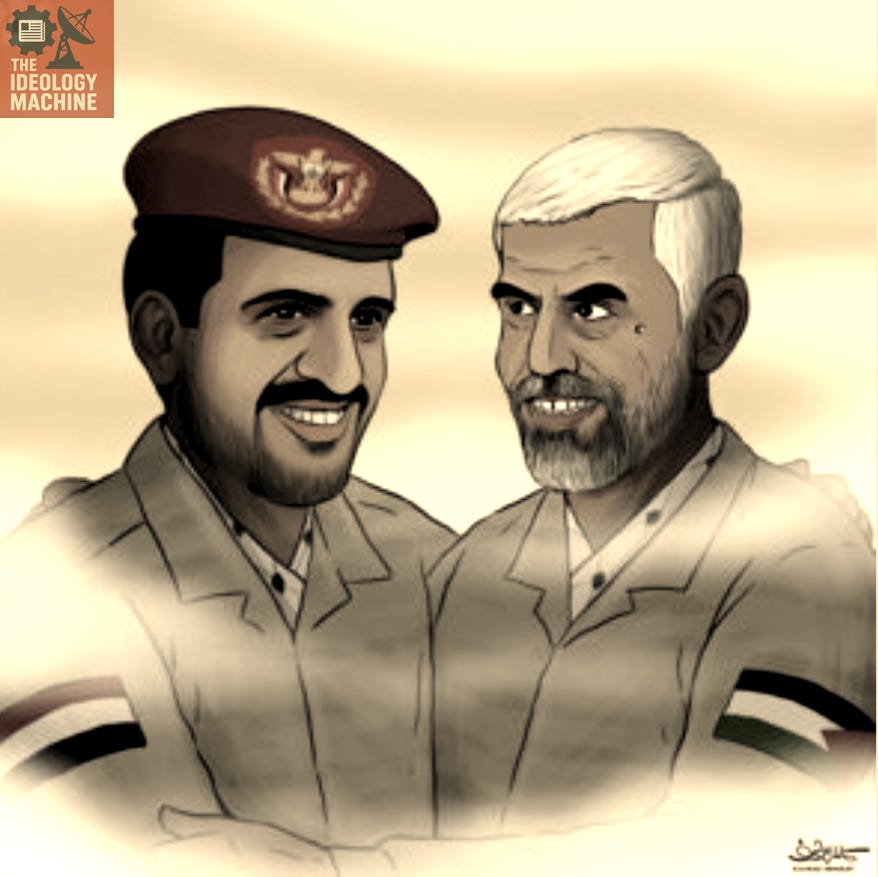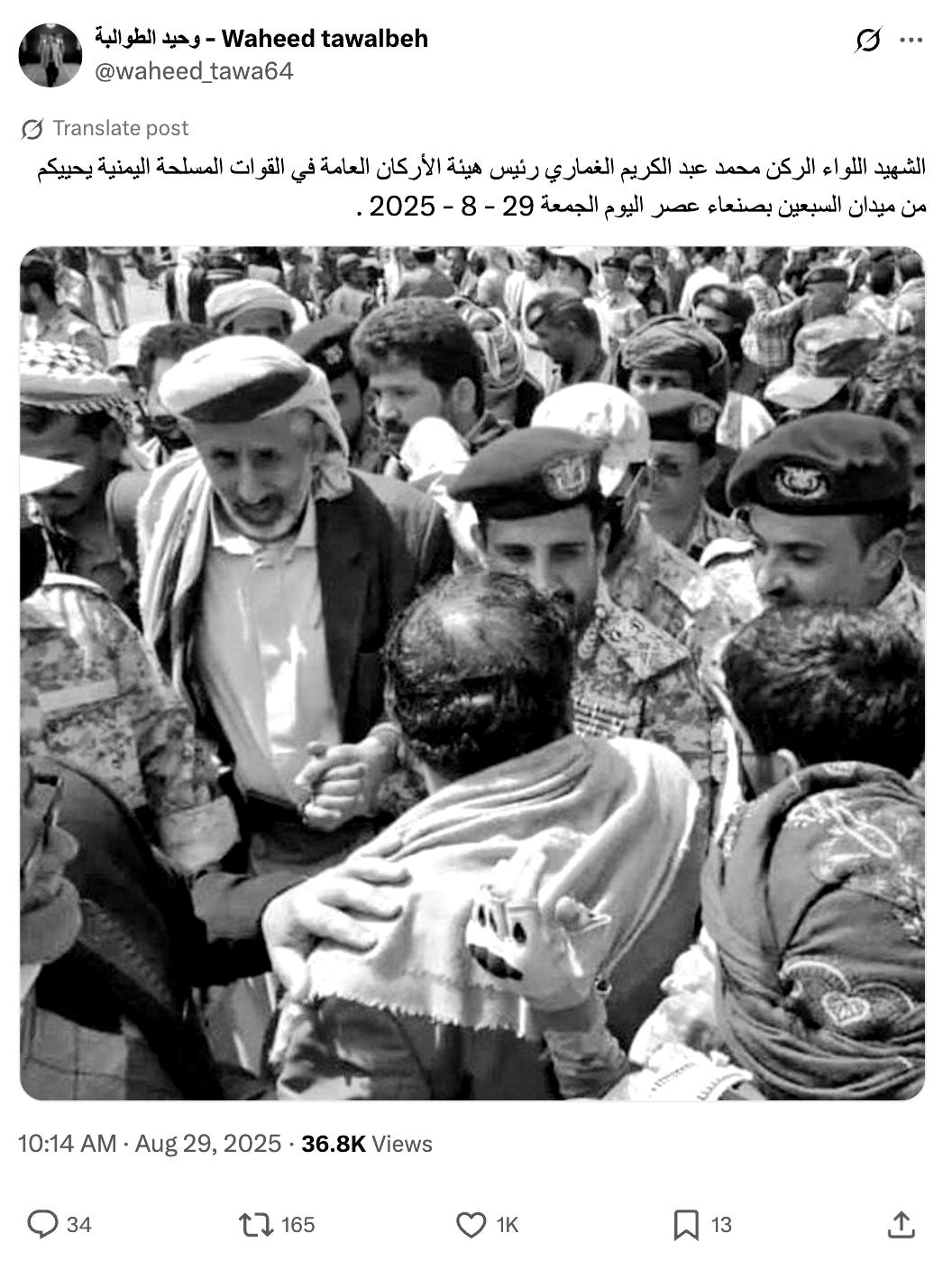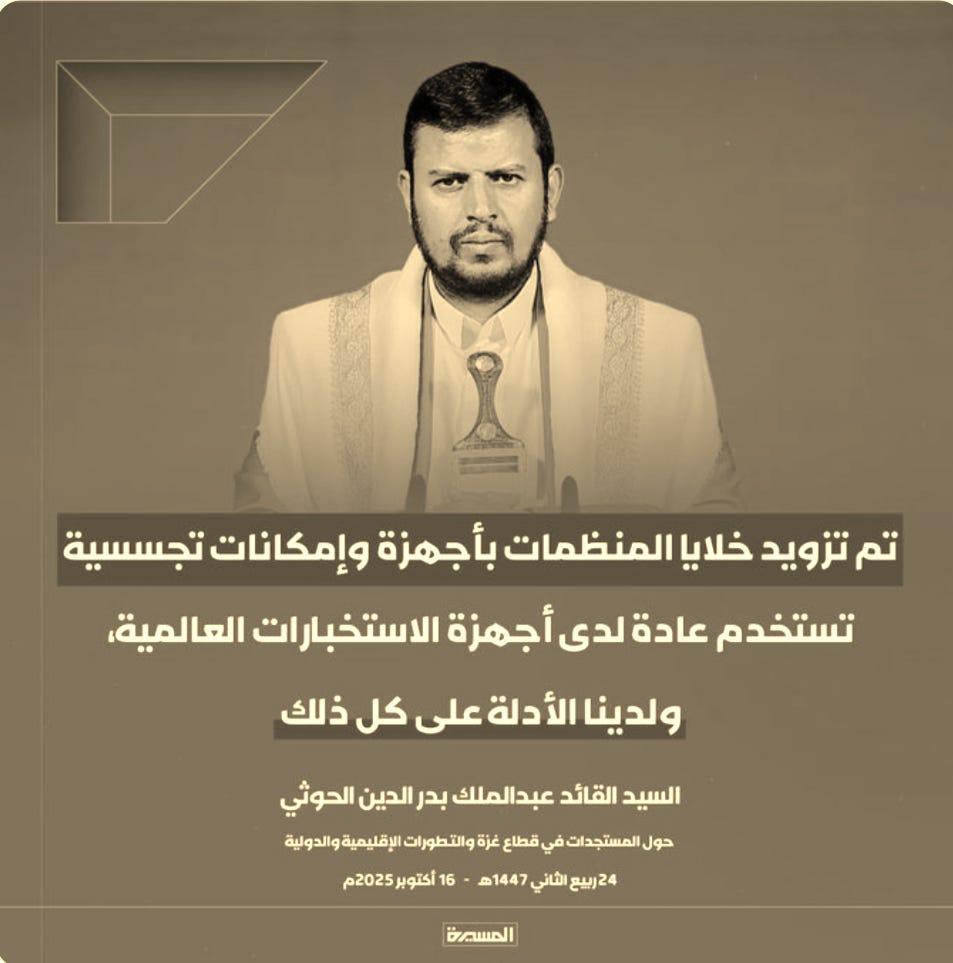Fighting the Wrong War Against the Houthis
What the delayed announcement of Houthi commander Mohammed al-Ghamari’s death tells us about the militia’s control over information and meaning.

On October 16, 2025, the Iran-backed Houthis confirmed what Israeli Defense Minister Israel Katz had announced weeks earlier: that al-Ghamari, the militia’s top military commander, had been killed in August strikes targeting senior Houthi officials in Yemen. But as the news broke, it created exactly the confusion the Houthi militia intended.
Because the exact date of his death was unknown, commentators obsessed over timelines: what date did he actually die? Debates about details followed, contradictory reports, demands for proof, arguments over whether the Houthis’ vague statement that he died “while fulfilling his duties” meant months ago or days before the announcement. Even Yemen’s Information Minister in the internationally recognized government joined in, calling out “dysfunction” and “contradictory messages,” as if the confusion itself weren’t the point.
What the debate missed is that the delay was structural. During those seven weeks, the Houthis quietly covered up and waited for the opportune moment to announce it, only when it served them. They installed al-Ghamari’s replacement, Youssef al-Madani, a hardline field commander with direct ties to Iran’s Islamic Revolutionary Guard Corps (IRGC) and a $20 million Saudi bounty on his head. Abdelmalik al-Houthi, the leader of the movement, timed the announcement to coincide with the anniversary of Hamas leader Yahya Sinwar’s death, framing al-Ghamari’s killing within a broader narrative of transnational martyrdom spanning Yemen, Gaza, and Tehran’s “Axis of Resistance.”

From al-Ghamari to al-Madani: Iran’s Man in Yemen
Abdulmalik al-Houthi attempted to justify the loss and save face in his October 16 speech, elegantly and manipulatively mourning Mohammed al-Ghamari’s death: “What our people offer of martyrs is a witness to the sincerity of their stance,” insisting such sacrifices “do not affect capabilities nor the strength of the stance.” Houthi-affiliated accounts circulated images depicting al-Ghamari and Sinwar side by side in military uniform. The iconography erases al-Ghamari’s record of domestic repression, obscures the distinction between Yemen’s conflict and Gaza’s, and manufactures a transnational martyrdom that serves Tehran’s regional project while demanding Yemeni blood as tribute.
The replacement reveals everything. Al-Ghamari was trained in missile engineering and was methodical in planning; in some way, he was an implementer and likely a strategist. Al-Madani, however, is an executor: a field commander who fought in all six wars against the Yemeni government between 2004 and 2010, trained with Iran’s IRGC in 2002, married to a daughter of founder Hussein al-Houthi. Saudi Arabia placed a $20 million bounty on him in 2017, the same amount reserved for top leadership.
In December 2023, following the seizure of the Galaxy Leader ship in November 2023, al-Madani stated: “any escalation in Gaza is an escalation in the Red Sea front.” Making it clear that he has internalized Tehran’s logic so completely that he no longer distinguishes between Yemen’s interests and Iran’s directives. The Houthis chose an executor, a man who will not hesitate, will not deliberate, will not require instructions when Tehran signals. This is how proxy relationships calcify into structural dependency: through elevating those who have made the patron’s imperatives indistinguishable from their own identity.
Meanwhile, Tehran’s condolences for al-Ghamari made the hierarchy explicit. Iranian Chief of Staff Abdul Rahim Mousavi praised him for his “strategic role in defending the honor and independence of the Yemeni people and supporting the Palestinian cause,” mourning him not as a Yemeni leader serving Yemen, but as an implementer of a regional resistance strategy directed from Tehran. Yet for the Islamic Republic of Iran, which had suffered multiple high-profile losses across the Axis of Resistance, al-Ghamari’s death was not operationally consequential—they knew he was replaceable. He was a pawn, not a bishop, and the system had already produced his successor
For the Islamic Republic of Iran, the “Axis of Resistance” functions as an ideological franchise. Local grievances are harvested and repackaged to fuel regional ambitions. Movements adopt the language of liberation while constructing new forms of domination. Palestinian solidarity becomes the cover under which the Houthis expand their machinery of coercion domestically, and no one inside the system can challenge it without appearing to betray the cause itself.
Gaza Solidarity as Cover for Domestic Crackdowns
The Houthis’ handling of Gaza solidarity demonstrates this mechanism perfectly. What began as genuine public sympathy for Palestinians under siege has been systematically transformed into compulsory performance: attendance monitoring at rallies, punishment for non-compliance, slogans of justice emptied of all meaning except obedience. The militia doesn’t suppress solidarity; it weaponizes it.
Al-Houthi’s October 16 speech extended this further, alleging that UN staff operated as espionage cells, declaring humanitarian organizations play “an aggressive, criminal role” with “nothing” protecting them from prosecution. Since mid-2024, Houthi forces have detained dozens of UN staff and aid workers; one World Food Programme employee died in custody approximately three weeks after being detained in January 2025. Each crackdown is preceded by speeches that pre-justify repression as counter-espionage.

The repression is narrative enforcement that has become policy. Question the resistance and you serve foreign intelligence. Challenge the narrative and you betray the cause. The system has made criticism structurally indistinguishable from treason. The militia speaks constantly of liberation while perfecting techniques of domination. Because the language of resistance has been monopolized and redeployed as an instrument of control, there is no vocabulary left for opposition that doesn’t already implicate the speaker as an enemy.
This is how non-state actors achieve control without a formal state apparatus, by monopolizing the language through which dissent could be articulated. The Houthis haven’t banned criticism of their policies; they’ve made it structurally impossible to criticize without appearing to betray Palestine, abandon resistance, or serve foreign intelligence. The militia forecloses opposition by collapsing all political vocabulary into a single frame it controls.
Martyrdom as Manufactured Commodity
The Houthis have built a machinery of martyrdom production that sacrifices their followers while exalting their commanders. Summer camps indoctrinate children into viewing their own deaths as spiritual fulfillment and in some cases, sacrifice for a larger antisemitic cause disguised as support for Gaza. The Martyrs Foundation embeds this doctrine in governance, funds families of the fallen, stages public rituals, and transforms private grief into public fealty. Funeral processions function as loyalty tests. The machinery operates with industrial efficiency: mass-produced martyrdom, standardized sacrifice, death as the only legible form of political participation.
As such, Houthis created subjects who cannot articulate resistance in any language the system doesn’t already own. Faith and fear become indistinguishable. Governance rests not on service or accountability but on the choreographed spectacle of sacrifice. The Houthis don’t suppress dissent; they make dissent unthinkable by making martyrdom the sole currency of political legitimacy
The Limits of Military Action Without Information Strategy
The militia has engineered information control into its operational DNA, not as auxiliary but as a load-bearing structure. What’s required is a counter-narrative strategy that exposes how the Houthis exploit faith, martyrdom, and solidarity to sustain repression. Without challenging the ideological economy itself, without making visible the mechanisms by which the system produces obedience that resembles conviction, every strike just provides more raw material for the performance of endurance.
The death of Mohammed al-Ghamari matters, but what the Houthis did with it matters more. They proved they could absorb a major loss, control the narrative around it, and use the delay itself as a demonstration of power. The seven-week silence wasn’t damage control—it was the strategy.
Al-Madani will likely prove himself through visible action: renewed offensives in Marib, tightened sieges in Taiz, and escalated maritime operations in the Red Sea. These won’t necessarily serve Yemen’s interests—they’ll be demonstrations of loyalty performed for Tehran, spectacles that maintain the performance of invincibility even as they extract costs from Yemeni civilians.
The question isn’t whether military strikes can eliminate Houthi commanders; they clearly can. The question is whether eliminating commanders changes anything when the ideology machine that produces them, legitimizes them, and converts their deaths into a sacred narrative remains untouched. Until there’s recognition that control over meaning is control over power, that the Houthis aren’t fighting for territory but for the right to determine what resistance means, the asymmetry persists. They’ll keep converting losses into proof of divine favor, and their opponents will keep destroying infrastructure while the belief system rebuilds itself overnight.

